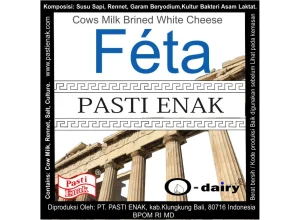Feta Cheese – A Taste of Greek Tradition
What Makes Feta Special
Feta Cheese is a white brined cheese with a tangy flavor and rich taste. Moreover, this national cheese of Greece can be firm or soft, creamy or crumbly, depending on the cheesemaker’s style.
Our Feta Varieties
PT. Pasti Enak® produces two main types of Feta: 100% Goat Milk and 100% Cow Milk. In addition, both types are available in a hot‑smoked version for those who enjoy deeper flavors.
Balkan Heritage
O‑dairy® Feta belongs to a family of brined cheeses traditionally made across the Balkan countries of Southeast Europe. Furthermore, this region, named after the Balkan Mountains, is home to lush fields where sheep, goats, and cows graze. Historically, herders relied on sheep and goats; however, modern dairy farms now raise cows as well. As a result, brined cheeses remain staples of local cuisine, reflecting the diverse climates and cultures of the area.
Traditional Production in Indonesia
We craft our Feta using methods developed in Greece. In addition, production takes place in our Bali facility, making these cheeses proudly Indonesian. We use the name “Feta” as a tribute to the Greek masters who perfected authentic PDO Feta. Although we adapt certain steps, our process stays close to traditional Balkan cheese‑making practices.
How We Make It
First, we pasteurize, test, and filter fresh milk before adding special cheese cultures. Then, the milk coagulates and is cut into curds. While the whey drains away, the curds are collected and packed into molds. Finally, the cheese is shaped and prepared for aging.
Barrel‑Aged Flavor
Pasti Enak Feta ages in barrels for at least two months. Afterward, we store it in brine for additional maturation. On average, our Feta reaches full flavor after four months. Therefore, each wheel offers a balanced taste that blends tanginess with creaminess.
A Glimpse of History
Greek mythology credits Apollo’s son Aristaeus with teaching the art of cheese‑making. Homer also describes cheese in The Odyssey, where Odysseus finds racks of cheese in the Cyclops Polyphemus’s cave. Consequently, these references show that aged cheese has been part of Greek life for centuries.
Other Brined Cheeses
Across the Balkans and beyond, many cheeses share similarities with Feta. For example:
- Sfela – Semi‑hard cheese from Southern Greece.
- Batzos – Low‑fat brined cheese from Macedonia and Thessalia.
- Kalathaki Limnou – Soft cheese shaped in traditional baskets.
- Telemes (Telemea) – Acidic, crumbly cheese from Romania, often made with cow’s milk.
- Bjalo Salamureno Sirene – Smooth Bulgarian brined cheese.
- Belir Sir U Kriškama – Serbian white cheese with regional variations.
- Beyaz Peynir – Turkey’s most popular brined cheese, accounting for 60% of national production.
Cooking with Feta
Because Feta is preserved in salt, it tastes saltier than many cheeses. However, you can reduce saltiness by soaking cubes of Feta in fresh water for a few hours before serving. As a result, the flavor softens and becomes more balanced.
Minimum Weight: 180 grams















